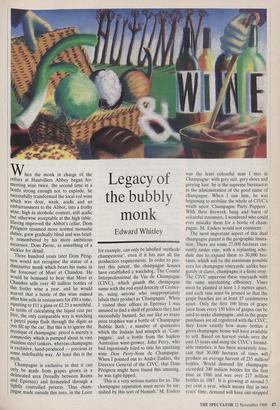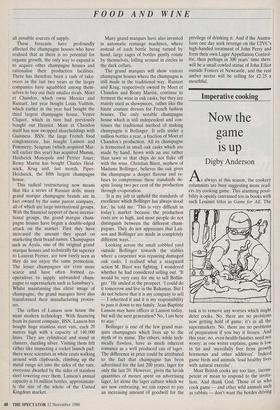Legacy of the bubbly monk
Edward Whitley
hen the monk in charge of the cellars at Hautvillers Abbey began fer- menting wine twice, the second time in a bottle strong enough not to explode, he successfully transformed the local red wine Which was dour, weak, acidic and an embarrassment to the Abbot, into a frothy Wine, high in alcoholic content, still acidic but otherwise acceptable at the high table. Having improved the Abbot's cellar, Dom Perignori resumed more normal monastic duties, grew gradually blind and was brief- ly remembered by his more ambitious successor, Dom Pierre, as something of a stickler for detail. cellars at Hautvillers Abbey began fer- menting wine twice, the second time in a bottle strong enough not to explode, he successfully transformed the local red wine Which was dour, weak, acidic and an embarrassment to the Abbot, into a frothy Wine, high in alcoholic content, still acidic but otherwise acceptable at the high table. Having improved the Abbot's cellar, Dom Perignori resumed more normal monastic duties, grew gradually blind and was brief- ly remembered by his more ambitious successor, Dom Pierre, as something of a stickler for detail.
Three hundred years later Dom Perig- non would not recognise the statue of a diminutive monk which bears his name in the forecourt of Moet et Chandon. He would be bemused to hear that Moet et Chandon sells over 40 million bottles of this frothy wine a year, and he would marvel that a bottle of this wine named after him sells in restaurants for £90 a time, equating to ill a glass or £2.25 a mouthful. In terms of calculating the liquid cost per litre, the only comparable way is watching a petrol pump flash through the digits as You fill up the car. But this is to ignore the mystique of champagne: petrol is merely a commodity which is pumped about in vast tainless steel tankers, whereas champagne Is exclusive, hand-produced — precious in some indefinable way. At least this is the myth.
Champagne is exclusive in that it can only be made from grapes grown in a delineated area (broadly between Reims and Epernay) and fermented through a tightly controlled process. Thus cham- Pagne made outside this area, in the Loire for example, can only be labelled `rnethode champenoise', even if it has met all the production requirements. In order to pro- tect this patent, the champagne houses have established a watchdog, The Comite Interprofessional du Vin de Champagne (CIVC), which guards the champagne name with the red-eyed ferocity of Cerber- us, suing anyone who inappropriately labels their product as 'Champagne'. When I visited their offices in Epernay I was amused to find a shelf of products they had successfully banned. Set out like so many prize trophies was a bottle of 'Champagne Bubble Bath', a number of spumantes which the Italians had misspelt as 'Cam- paggne', and a bottle from the hapless Australian wine-grower, John Perry, who had ingeniously tried to title his sparkling wine Don Perry-Nom de Champagne. When I pointed out to Andre Enders, the Director General of the CIVC, that Dom Perignon might have found this amusing, he was tight-lipped. 'This is a very serious matter for us. The champagne reputation must never be tar- nished by this sort of blemish.' M. Enders was the least colourful man I met in Champagne: with grey suit, grey shoes and greying hair, he is the supreme bureaucrat in the administration of the good name of champagne. When I saw him, he was beginning to mobilise the whole of CIVC's wrath upon 'Champagne Party Poppers'. With their firework bang and burst of colourful streamers, I wondered who could ever mistake them for a bottle of cham- pagne. M. Enders would not comment.
The most important aspect of this dual champagne patent is the geographic limita- tion. There are some 27,000 hectares cur- rently under vine, with a replanting sche- dule due to expand these to 30,000 hec- tares, which will be the maximum possible area for champagne vineyards: unlike bur- gundy or claret, champagne is a finite crop. The CIVC supervise these vineyards with the same unrelenting efficiency. Vines must be planted at least 1.5 metres apart, and each vine must be pruned so that the grape bunches are at least 15 centimetres apart. Only the first 100 litres of grape juice from every 150 kilos of grapes can be used to make champagne, and as the grape purchases are all registered with the CIVC, they know exactly how many bottles a given champagne house will have available to sell. Based on harvest yields over the past 15 years and using the CIVC's formid- able statistics, it has been accurately fore- cast that 30,000 hectares of vines will produce an average harvest of 235 million bottles. World demand for champagne exceeded 200 million bottles for the first time in 1986 and was over 217 million bottles in 1987. It is growing at around 5 per cent a year, which means that in two years' time, demand will have out-stripped
FOOD AND WINE
all possible sources of supply.
These forecasts have profoundly affected the champagne houses who have realised that as there is no potential for organic growth, the only way to expand is to acquire other champagne houses and rationalise their production facilities. There has therefore been a rash of take- overs in the last two years as the larger companies have squabbled among them- selves to buy out their smaller rivals. Moet et Chandon, which owns Mercier and Ruinart, last year bought Louis Vuitton, which earlier in the year had bought the third largest champagne house, Veuve Cliquot, which in turn had previously bought out Henriot. Moet et Chandon itself has now swopped shareholdings with Guinness. BSN, the large French food conglomerate, has bought Lanson and Pommery; Seagram (which acquired Mar- tell earlier this year) has acquired Mumm, Heidseick Monopole and Perrier Jouet; Remy Martin has bought Charles Heid- seick, Krug and, last month, Piper- Heidseick, the fifth largest champagne house.
This radical restructuring now means that like a series of Russian dolls, many grand marque champagne brands are in fact owned by the same parent company, all of which are large international groups. With the financial support of these interna- tional groups, the grand marque cham- pagne houses have begun a double-edged attack on the market. First they have increased the amount they spend on marketing their brand names. Champagnes such as Ayala, one of the original grand marque houses and technically far superior to Laurent Perrier, are now rarely seen as they do not enjoy the same promotion. The lesser champagnes are even more scarce and have often formed co- operatives to supply unbranded cham- pagne to supermarkets such as Sainsbury's. Whilst maintaining this elitist image of champagne, the grand marques have also transformed their manufacturing proces- ses.
The cellars of Lanson now house the most modern technology. With financing from its parent company, BSN, Lanson has bought huge stainless steel vats, each 20 metres high with a capacity of 140,000 litres. They are cylindrical and stand in clusters, dazzling silver. Visiting them felt rather like inspecting a rocket launch pad: there were scientists in white coats walking around with clipboards, climbing up the metal rungs set into the sides of the vats, everyone dwarfed by the sides of stainless steel towering over them. Lanson's annual capacity is 14 million bottles, approximate- ly the size of the whole of the United Kingdom market. Many grand marques have also invested in automatic remuage machines, where instead of each bottle being turned by hand, large cages of bottles gently rotate by themselves, lolling around in circles in the dark cellars.
The grand marques will show visitors champagne houses where the champagne is still made in the traditional way. Ruinart and Krug, respectively owned by Moet et Chandon and Remy Martin, continue to ferment the wine in oak casks, but they are mainly used as showpieces, rather like the haute couture dresses for French fashion houses. The only notable champagne house which is still independent and con- tinues the traditional method of making champagne is Bollinger. It sells under a million bottles a year, a fraction of Moet et Chandon's production. All its champagne is fermented in small oak casks which are made by hand, hewn with an axe rather than sawn so that chips do not flake off with the wine. Christian Bizot, nephew of Madame Bollinger, believes the oak gives the champagne a deeper flavour and re- fuses to compromise these standards de- spite losing two per cent of the production through evaporation.
'It is my job to uphold the standards of excellence which Bollinger has always stood for,' he told me. 'This is very difficult in today's market because the production costs are so high, and most people do not distinguish between the different cham- pagnes. They do not appreciate that Lan- son and Bollinger are made in completely different ways.'
Looking across the small cobbled yard outside Bollinger towards the stables where a carpenter was repairing damaged oak casks, I realised what a rearguard action M. Bizot was fighting. I wondered whether he had considered selling out. 'It would be very easy for me to sell Bollin- ger.' He smiled at the prospect. 'I could do it tomorrow and live in the Bahamas. But I do not believe that it is my company to sell — I inherited it and it is my responsibility to pass it down to my family. Jean-Baptiste Lanson may have offices at Lanson today, but will the next generation? No, I am here to stay.'
Bollinger is one of the few grand mar- ques champagnes which lives up to the myth of its name. The others, while tech- nically flawless, have as much inherent romance as a well produced can of lager. The difference in price could be attributed to the fact that champagne has been advertised for the last 200 years, lager for only the last 20. However, given the lavish quantities of money spent on advertising lager, let alone the lager culture which we are now embracing, we can expect to pay an increasing amount of goodwill for the privilege of drinking it. And if the Austra- lians one day seek revenge on the CIVC's high-handed treatment of John Perry and form their own Lager Appellation Control- lee, then perhaps in 300 years' time there will be a small cowled statue of John Elliot outside Fosters et Newcastle, and the real amber nectar will be selling for £2.25 a mouthful.











































































 Previous page
Previous page